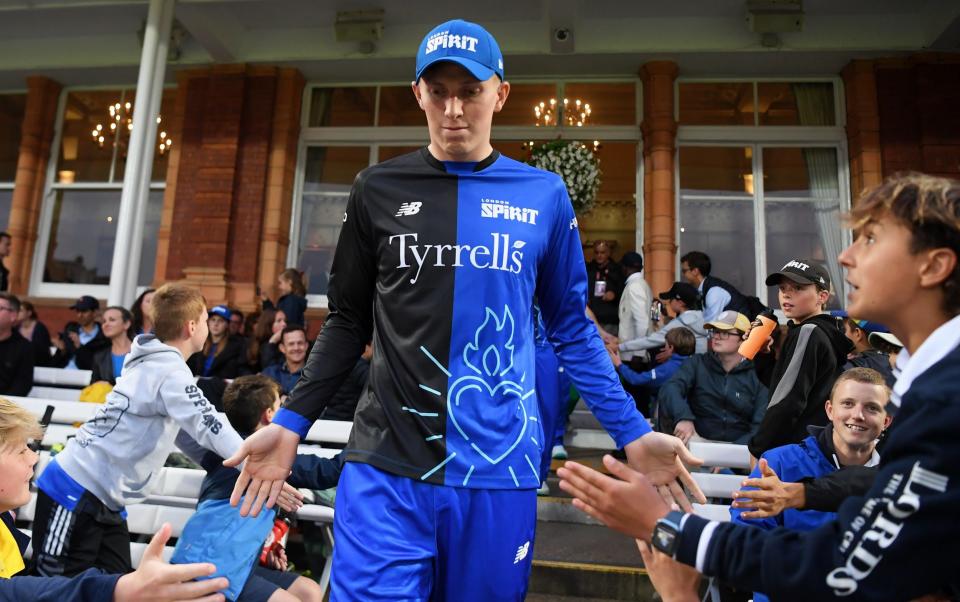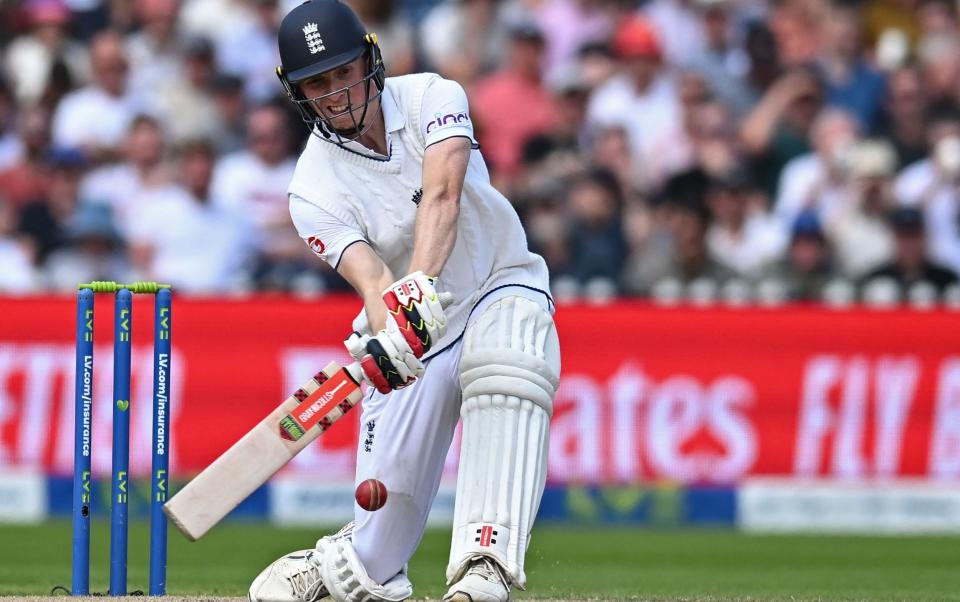
One of the many curiosities about Zak Crawley’s England career is that an audacious, buccaneering yet inconsistent batsman has spent his first four years as an international cricketer as a red-ball specialist. Bar three one-day internationals against Pakistan in 2021, when part of England’s hastily compiled reserve squad after Covid-19 had run through the first-choice party, Crawley has only been glimpsed for England in whites.
In part, this reflects England’s abundance of white-ball batting talent. And in part, it reflects the relentless international schedule: England have spent much of the past four years with separate squads.
Yet, to see him driving Pat Cummins’ opening ball of the Ashes to the extra cover boundary, his stunning 189 at Old Trafford and his sheer enterprise innings after innings against the new ball, has invited the question of what Crawley could do against the white ball. Certainly, there is no sense that his ambitions are sated by being a Test specialist. He declares that he would “love” to play in all three formats for England, with his aspirations to return to the Big Bash this winter and, potentially, enter the Indian Premier League auction, an indication of his ambitions to develop his white-ball game. England also have a need to develop younger white-ball openers: Alex Hales has just retired; Jonnny Bairstow, Jason Roy and Dawid Malan are all at least 33.
Aggressive Test batsmen do not always transfer successfully to the white-ball game. Michael Slater, Matt Prior, Michael Vaughan and VVS Laxman were all enterprising Test players who failed to be as effective in limited-overs cricket, where they struggled against opposition fields focused on cutting off their boundaries. Test batsmen who thrive on counter-attacking see very different dynamics in the shortened formats.
But Crawley appears well-suited to making the switch. “It should hopefully be a pretty easy transition,” he tells Telegraph Sport. “My game’s pretty similar. I’ve just got in the nets in the last few days and I’ve just been trying to be a little bit more aggressive and maybe a bit more aerial and working on those kind of shots.” Asked about a model of how to play in T20, Crawley cites James Vince. “He’s a very natural player… I feel like that’s quite similar to my game.”
Two shots are particularly essential for openers against pace, believes Zubin Bharucha, the strategy director at Rajasthan Royals who is regarded as one of T20’s most pioneering thinkers. First, driving the ball on a good length. Then, when the quicks respond by bowling shorter, pulling deliveries that are just short of a length, off the front foot. Happily, for Crawley, these are perhaps his two defining shots, as Australia’s Test quicks could attest.
For Test batsmen, being taller generally hasn’t been better. Of the 28 players to score 5,000 Test runs at an average of over 50, just four – Jacques Kallis, Greg Chappell, Matthew Hayden and Joe Root – are over six foot, illustrating how extra height can create difficulties for batsmen: tall players generally have to play at more deliveries and might struggle to retain their balance. But in T20, with its emphasis on power – and the importance of reach, especially for balls wide of off stump – being as tall as Crawley’s 6ft 4in is advantageous. Height particularly helps with the pair of shots that Bharucha cherishes – the drive on the up and the front-footed pull.
Crawley is a little less powerful than some white-ball titans of similar build: he has only hit four sixes in his 39 Tests. But he still has sufficient heft to loft the ball over the in-field during the Powerplay. And he has also shown the capacity to clear the ropes in the shorter formats: Crawley has scored almost one six per game in T20.
No matter that Crawley has scarcely been seen outside of Test whites for England, he has an impressive white-ball pedigree. He has a T20 strike rate of 141 to go with his average of 29.4, and performed solidly for Hobart Hurricanes in last year’s Big Bash. While he hasn’t played a domestic one-day game since 2019, Crawley averaged 50.1 then. In his three ODIs against Pakistan in 2021 – batting at number three, rather than opening – Crawley averaged 48.5, with a strike rate of 114. His two-pronged attack on Shaheen Shah Afridi and Harris Rauf – driving anything fractionally full, and then rocking back to pull shorter deliveries – was entirely in keeping with England’s one-day philosophy, and a distillation of what Crawley could bring to the white-ball side.
At World Cups, rapid bowling plays a bigger part than in Test cricket: with fewer overs per bowler, quicks tend to be able to bowl at their quickest for longer. This should make Crawley more valuable, given his unusual skillset: while often struggling against slower seamers, he averages 51 against balls over 87mph in Tests.
For all his trust in his fundamental game, Crawley is also trying to expand his repertoire for the white-ball formats. He is focusing on developing sweeps and reverse-sweeps – a shot that he deployed effectively against Nathan Lyon – and a ramp against pace.

“I haven’t played it too much in recent times, but before I played for England I used to play it a lot more. So I’ve been trying to work on that and then try to bring it back in a little bit more and hopefully free up a couple other areas to score.” The comment is instructive: as Jos Buttler could attest, the value of a ramp lies not just in the runs it brings, but in how opponents’ awareness of it leads to them moving a fielder for the shot, freeing up areas elsewhere. Crawley unveiled the shot in the Hundred on Saturday, getting down low and flicking a ball from Luke Wood over short fine leg for four.
The Ashes also provided indications that Crawley can thrive against the negative fields often used in the white-ball game. When Australia adopted defensive fields, Crawley adapted – recognising that he could still score quickly, but that he could do so while eschewing risk.
In Test cricket, opening is often the worst time to bat. In white ball – when the ball tends to swing and seam less, the pitches are better and the fielding restrictions provide abundant boundary-scoring possibilities – opening is generally the best time to bat. After his improved performances in the Test arena, then, Crawley might consider an opportunity to prove his white-ball credentials overdue. He will surely get one before the year is out, with the series against Ireland and West Indies either side of the World Cup ripe for experimentation.
Article courtesy of
Source link